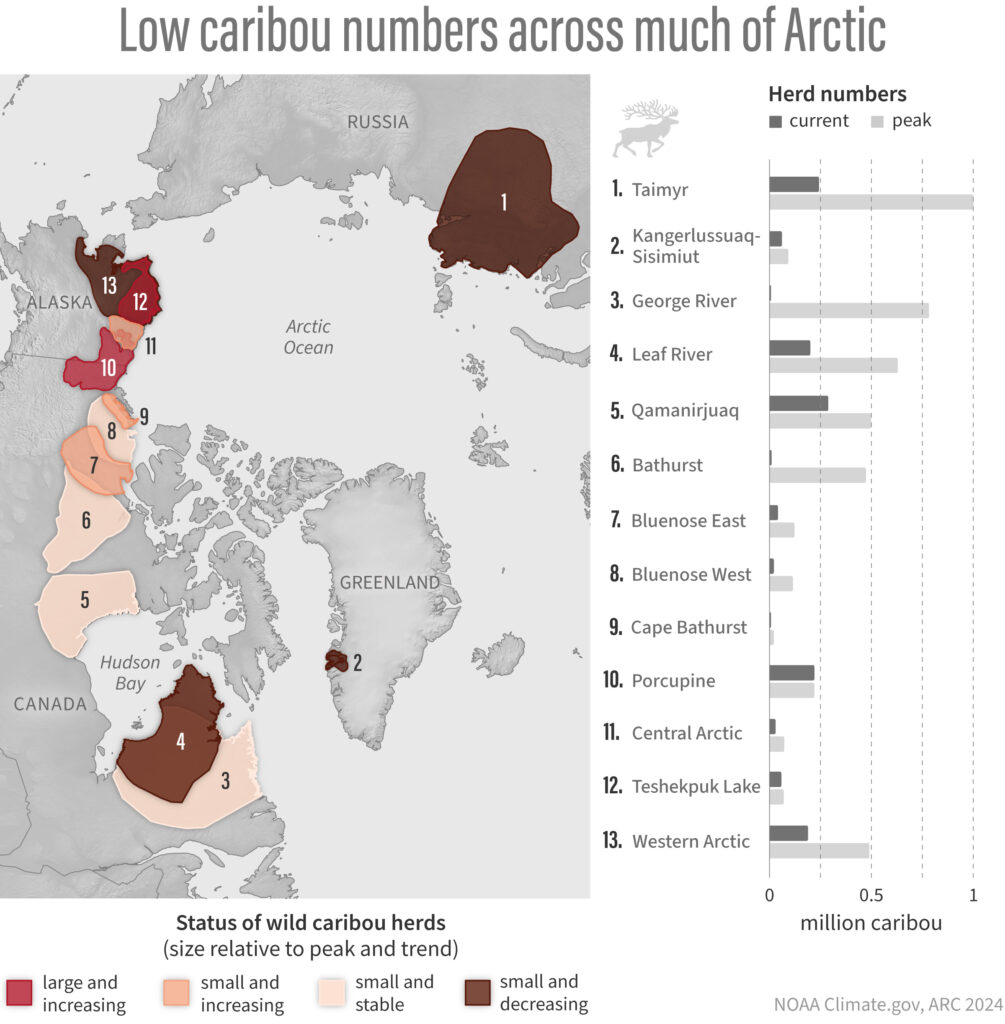© Monte HUMMEL / WWF-Canada
News
Climate challenges for Arctic caribou featured in NOAA’s 2024 Arctic Report Card
- Reindeer & Caribou
The latest edition of NOAA’s Arctic Report Card, released on 11 December, offers a comprehensive assessment of the rapidly changing Arctic environment. This vital report provides critical insights into the region’s climate, ecosystems, and wildlife, emphasizing the profound impacts of accelerating climate change.
A detailed study featured in the Report Card, Migratory Tundra Caribou in a Warmer Climate, explores the profound challenges facing Arctic caribou populations as rising temperatures and shifting environmental conditions alter their habitats and behaviors. Caribou, also known as reindeer in Eurasia, are critical to the Arctic ecosystem and deeply interwoven with Indigenous cultures and economies. The study, which drew on scientific insights supported by the WWF Global Arctic Programme emphasizes the importance of collaborative efforts in addressing the complex challenges faced by Arctic caribou.
Key Caribou Populations Studied
The research focuses on major migratory caribou herds across the Arctic, highlighting their unique vulnerabilities:
- Western Arctic Herd (Alaska, USA): This herd has experienced a 70 per cent decline since 2003, which harvesters attribute partly to climate change. With fewer snow patches in warmer summers, the herd struggles to avoid insect harassment.
- Bathurst herd (Canada): Hotter climate, mining, and mining roads are changing the herd’s ability to move across the landscape.The Bathurst herd has declined 97 per cent since the mid-1990s. Further declines are expected under accelerating climate change.
- Taimyr herd (Russia): As one of the largest herds globally, the Taimyr caribou are under pressure from habitat loss and encroachment of human activities driven by changing climate patterns.

© NOAA Climate.gov, ARC 2024
Major findings of the study
The study reveals a series of interconnected challenges threatening the survival of Arctic caribou:
- Overall population decline: Over the past 20-30 years, Arctic caribou numbers have dropped by 65 per cent. While some smaller coastal herds in the western Arctic are beginning to recover, larger inland herds remain at low numbers or continue to decline.
- Changing migrations: Warmer winters and less predictable snow patterns are altering when and where caribou migrate. These changes make it harder for caribou to reach their traditional breeding and feeding grounds, affecting their health and reproduction.
- Insect harassment: More insects and fewer snow patches in hot summers reduce the ability of herds to avoid insect harassment – they have less time to eat.
- Food shortages: When rain falls on snow, it creates a thick layer of ice on top. This makes it impossible for the animals to dig through the ice to reach the lichens they need to eat, leaving them in poor condition.
- Regional trends: The extent of these challenges varies by region. Areas projected to see the highest summer temperatures are likely to experience the greatest continued population losses.
- Multiple threats: Along with climate change, industrial development, habitat loss, and increased predation in some areas add to the stress on caribou populations.
Impacts on Indigenous communities
The caribou’s struggles ripple through Arctic communities, where these animals have long been a cornerstone of cultural traditions, food security, and livelihoods. For Indigenous Peoples, reduced access to healthy caribou populations means profound challenges in maintaining their way of life. Traditional hunting practices are affected as migration routes shift and herd sizes dwindle, while the economic reliance on caribou products becomes increasingly precarious.
Knowledge sharing for sustainable solutions
Sharing information and expertise is crucial to understanding and addressing the challenges faced by caribou. Indigenous communities, scientists, and policymakers must work together to study how climate change is affecting herd health and to develop strategies that support recovery. These efforts should also honor the deep cultural, nutritional, and spiritual connections northern peoples have with caribou.
By exchanging ideas and solutions, those managing caribou can create plans that ensure healthier herds while respecting traditional practices and knowledge. This collaboration is essential for protecting both caribou populations and the communities that rely on them.
Comprehensive, collaborative action is key to addressing these challenges. Protecting critical habitats, minimizing industrial impacts, and supporting Indigenous-led solutions are necessary to ensure the resilience of caribou populations and the communities they sustain.
The findings underscore the urgent need to tackle climate change globally while fostering local solutions to protect the Arctic’s unique biodiversity and cultural heritage. The challenges faced by caribou are a stark reminder of how deeply environmental changes are interconnected with human and ecological systems.
By WWF Global Arctic Programme